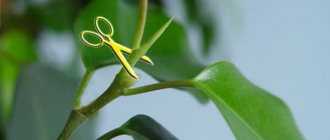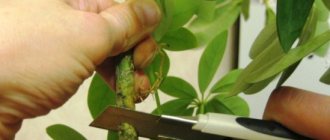Ficus is a plant loved by many gardeners, which has one feature: it only grows upward. Specimens growing in natural conditions can reach a height of forty meters. In apartment walls, owners often have a question: how to prune a ficus tree so as not to harm it. Some novice gardeners argue about how useful such manipulations are for the plant. Experts say that a procedure such as ficus transplantation and root pruning is an integral part of caring for this species.
It allows not only to form a tree of an original shape, but also to rejuvenate the crop.
Pruning and replanting the plant
Before pruning and replanting the ficus, it is necessary to assess the condition of the plant and determine whether it requires preliminary sanitary pruning of dry and non-viable shoots. It is also necessary to remove diseased branches. Sanitary pruning can be carried out at any time.
Proper formation of the plant will allow you to achieve unexpected results. In the skillful hands of a professional, these specimens can grow in the form of an arch or a bush, a trunk or a bonsai. However, each type of ficus has its own specific rules and nuances of the procedure. Therefore, it is very important for beginners in this business to inquire about the characteristics of a particular species before pruning a tall ficus. Before you start pruning, you should decide on the desired result.
You need to know in advance how to properly prune a certain type of ficus so that it has a branched crown and a powerful trunk, or becomes a small lush bush.
Preparing ficus for pruning
Proper crown formation requires knowledge of plant physiology. The ficus produces new shoots from the buds at the top and axils. The axillary ones are located where the petioles are attached to the trunk. Usually, developing much more intensively, the apical bud inhibits the activity of the others. In order to best stimulate their growth, it is important to determine when to prune the ficus and what period will be most successful for the plant’s life cycle. In spring, this flower receives the greatest amount of strength. It is during this period that pruning allows you to realize your ideas more successfully. Some beginners are interested in whether ficus is pruned in autumn and winter. The manipulation carried out at this time will help to achieve one-sided growth of the plant.
When starting the procedure, you need to prepare scissors, a knife or pruning shears. Before pruning an adult ficus, experts advise disinfecting all tools with alcohol. An infection introduced from a dirty instrument can destroy the flower. It is recommended to wipe all sections with a damp cloth until the juice is absorbed. Then this area must be sprinkled with charcoal.
Planting ficus and methods of its propagation
Such a plant can be planted using leaves or shoots. For planting, a cutting is selected, which is cut at an acute angle. It is immersed in warm water for a couple of hours, then the cut area is treated with wood ash. In addition, the flower can be propagated by air layering. Often gardeners are interested in whether it is possible to cut off the roots of a ficus, which can later be used for planting. In order for such roots to appear, an incision must be made at the top of the main trunk or side shoots and a small stick inserted there. This place is covered with damp moss and tied with cellophane. In a month, roots will appear on the branch. For planting, the bottom of the pot is lined with drainage. It can be stone, shards or expanded clay. The drainage layer is covered with moss so that it retains the soil and prevents it from clogging the drainage holes.
Flower care after the procedure
Pruning the crown is stressful for the flower. Ficus needs help to survive it.
For this, certain conditions are created:
- regular watering with warm and settled water;
- fertilizing with nitrogen fertilizers - every 3 weeks;
- maintaining a constant temperature within +22-25 degrees.
The plant will also have to be protected from drafts. You cannot spray the ficus yet, so as not to provoke rotting of the cuts. Periodically, the flower should be inspected for the presence of parasites or signs of disease.
What to process?
The open cut should not be left bare. Fungus and microbes easily penetrate through damaged tissue. With proper treatment, wounds heal faster and the decorative characteristics of the plant improve.
The following means are suitable for disinfection:
- Powder made from charcoal or activated carbon. It not only disinfects wounds, but also dries them.
- Clay chatter. Made from clay, water and mullein.
- Flax putty is a mixture of oil and furnace soot. After drying, it turns into a thin polymer film.
Peculiarity! First, wipe the cut with a damp cloth to remove the milky juice from it. Only after this are antiseptic agents applied.
Sources
- https://domashniecvety.ru/obrezka-fikusa-v-domasnih-usloviah-formirovanie-krony-kusta-ctoby-byl-pusistyj/
- https://vashcvetok.ru/vyrashhivanie/fikus-elastica-obrezka-i-formirovanie
- https://ufermer.com/komnatnye-rasteniya/fikus/kak-obrezat-fikus.html
- https://kaktys.club/sovety-novichkam/obrezka/kak-obrezat-fikus
- https://www.komy-za30.ru/beauty-life/kak-obrezat-fikus
- https://TrubyMaster.ru/fikus-mozhno-li-obrezat-stvol/
A massive, richly decorated chandelier was an integral attribute of the interior of palace chambers and apartments. It gave the decor a luxurious look and emphasized the wealth of the owner of the room. Many people still strongly associate this type of lamp with crystal, although this is far from the only material from which modern lighting equipment can be made. For those wishing to buy a chandelier in Moscow, Vam-Market offers more than 15 thousand models in different styles. Crystal and glass, wood, plastic, ceramics, textiles, metal and other materials are used to make lamps.
Pruning rubber ficus
Being a more decorative ficus, this species is more compact and created specifically for home conditions. Most often its height reaches ten meters. It is very important for the owner to know how to properly prune the rubber-bearing ficus so that this variety begins to look more miniature and graceful.
This instance allows you to create any shape. Before pruning the rubber ficus, you need to familiarize yourself with the pruning rules and adhere to them. Even a novice florist can cope with this task. As a result, knowing how to prune a ficus beautifully, you can turn a nondescript flower into a unique home decoration.
Ficus benjamina must be pruned using new shoots that grow from the buds. There are only two such places on the flower - the apex and the lateral bud, which is located in the axils of the leaves. The apical bud is responsible for the rapid upward growth of the plant. At the same time, it is much ahead of the lateral buds, which develop too slowly. Sometimes axillary growth points do not show signs of activity and are in a dormant state. Therefore, it is important to know how to prune a ficus so that it bushes and looks more magnificent.
Removing the top bud will give the flower a chance to develop side shoots, which usually begin to grow in a variety of directions. After such manipulation, the plant can begin to change its crown.
Many beginners in floriculture, starting to work with ficuses, are interested in whether it is possible to trim the top of the ficus so that it stops growing into one shoot. Experts say that if other species fork after this procedure, then the rubber ficus can continue to grow. Before pruning a large ficus, you need to find short internodes on its shoots. A horizontal cut should be made just before the bud if the shoot is green and young. A plant with a hardened trunk is cut in the same place, however, at an oblique.
You should not leave tall stumps, which not only do not look aesthetically pleasing, but can also become a place for fungal diseases to accumulate and multiply.
Creating unusual shapes
Standard tree
The trunk is created by freeing the trunk from young leaves and twigs to the required height. At the same time, the top is also shortened, and a spherical crown is created around the stem, the correct shape of which must be constantly maintained by removing shoots and pinching leaves in the upper internodes.
Fence
After the mature rubber ficus has been pruned, you can start creating an interesting display in the form of a hedge or fence. Shoots that have been cut off are suitable for this. They are rooted in a shallow but fairly spacious box in one row. As they grow, you can attract the trunks to each other, cutting off the bark at the point of contact and tightly fixing the “wounds” together with film and wire. The more light there is in the room, the faster the branches will grow together at the points of contact and you can start a new row.
Spiral
To obtain a spiral shape, the tree is tied to a strong base (post or stick) and gradually twisting the trunk, securing it with wire or cord. Side branches and leaves should be removed to expose the beautiful, spiral-shaped stem.
Scythe
A very popular type of ficus formation. To do this, 3 young sprouts are planted in a box, and as they develop, the trunks are intertwined in the form of a pigtail, fixing them at the point of contact with polyethylene and wire. At the place of fixation, the bark is removed with a sharp knife, and the milky juice that appears in the “wound” is wiped with a cloth. It is most convenient to start weaving when the plant reaches 15-18 cm in height. The next fixation is carried out as the trunk lengthens, and the lower leaves and shoots are removed.
Pruning is not always necessary to create a neat crown. Ficus provides ample opportunities for flower growers to express their imagination. By following the rules for caring for it, you can create interesting compositions, decorate it in the form of a tree or achieve increased bushiness, thereby decorating the space with an original indoor flower. At the same time, you will not injure the plant, for which cutting is always a powerful stress.
Ficus pruning Melanie
Being one of the varieties of rubber ficus, this specimen also needs pruning. At the beginning of its growth period, this plant is an unbranched trunk with a woody stem. Over time, Melanie begins the process of branching, aerial roots appear, which, reaching the soil, form new trunks. Every owner of this unpretentious species should know how to prune ficus Melanie so that the plant retains its beauty and brightness.
Typically, pruning of this specimen is done at the end of winter. Experts advise how to trim a ficus so that it is fluffy, and emphasize that to do this it is necessary to get rid of the six internodes on top. By cutting off just the top, the grower will not be able to achieve lush development of the branches.
For those who are unsure whether they should prune their ficus this year, there is another method to force the flower to produce side shoots. To do this, the barrel is tilted as low as possible and fixed in this position. After this manipulation, dominance will be transferred to the lateral bud, which is located above the others. The growth of the crown will be stopped, and active growth of lateral shoots will begin.
How to prune ficus bonsai correctly?
Growing an indoor plant in the bonsai style is a whole science that requires patience, special knowledge and skills. Such compositions look like small works of art. Many experts advise beginners who want to learn this art form to begin their acquaintance with bonsai by growing ficus. This indoor plant is quite unpretentious and has all the qualities for this purpose.
By growing this tree, a beginner will learn how to trim ficus leaves and how to properly care for the plant. It is believed that the most suitable species for creating bonsai will be such species as ficus benjamina, ginseng, panda, ficus sacred, bengal, carika, dark-leaved, retuza and others. It is important for a beginner to learn how to prune a ficus bonsai in order to get a tree with an erect trunk of the correct shape or an original curve in some places. You can also create a plant with an inclined trunk and everted roots. Knowing how to properly trim the roots of a ficus and give it the necessary shape allows you to decorate your home with plants with a forked trunk or a composition of several trees.
To form the desired shape of the crown, you can use special devices that can pull the shoots away from the main trunk, adjust the angle between parts of the plant, and fix the branches in the required position. After some time, all these devices must be removed; the shoots themselves will continue to grow in the given direction.
Deadlines
The time for pruning is selected taking into account its purpose.
- Withered leaves, damaged and dry shoots are removed urgently. Delay is dangerous due to excessive outflow of nutrition to already limp foliage and short-lived stems. Also, when old plant tissue begins to rot, there is a risk of developing infections.
- The period of active growth is better suited for the formation of the crown - from the first days of March to June inclusive.
- The newly transplanted ficus is given time to adapt. Only when fresh leaves and shoots appear can it be trimmed.
For decorative purposes, the procedure is not carried out at the resting stage.
- Firstly, in winter shoots grow only in places where they are cut; other branches do not grow. As a result, the tree turns out to be disproportionately folded and curved.
- Secondly, all the plant’s forces will be redirected to the formation of fresh branches. This will weaken it significantly and it may not withstand the cold.
Some gardeners, in addition to the generally accepted rules, use the lunar calendar, taking into account the favorable phases of the moon:
- on a growing one - increased growth begins;
- decreasing - after pruning, the plant will retain its shape for a long time;
- On the new moon, diseased and dry branches are removed.
How to prune ficus Natasha correctly?
This species is one of the shortest among Benjamin's ficuses growing as a shrub. At home, this specimen grows up to forty centimeters. Its trunks are very flexible and thin, so they can be twisted several times, forming one plant with an original crown.
To properly trim ficus Natasha and get a lush green crown, you should wait until the end of February. During this period, leaf buds appear. Experts consider the pruning procedure for this ficus mandatory. Branches that have become too long, thin and weak require pruning. In addition to how to prune a house ficus to create a beautiful shape, you need to take care of its health and remove dry branches, as well as those damaged by scale insects or other pests.
The cut must be made above the kidney. Special garden shears are best suited for this purpose. Thick shoots are pruned obliquely, thin shoots are pruned straight.
Ficus Microcarpa - formation features
This specimen at first glance resembles Ficus Benjamin. However, it differs from its relative in that its rhizomes grow very quickly. Thanks to this fact, Ficus Microcarpa becomes an ideal choice for those who are beginning to get acquainted with the art of bonsai. Not being particularly difficult to care for, this specimen will not only attract novice gardeners. It survives well in very humid rooms and is not particularly capricious, although it does not tolerate drafts or sudden temperature changes.
In fact, how to prune Ficus Microcarpa is practically the only thing a beginner needs to learn. To form a lush crown, this tree needs regular pruning several times a year. The best time to prune this type of ficus is spring and summer. During this time, it is necessary to regularly shorten the shoots. Regarding the question of whether it is possible to trim the trunk of a ficus, experts answer unequivocally - yes. This action will increase the thickness and power of the trunk of this small ornamental tree. When forming a bonsai tree from this type of ficus, it is recommended to shorten each branch after 6-10 leaves appear on it, leaving only three or four.











